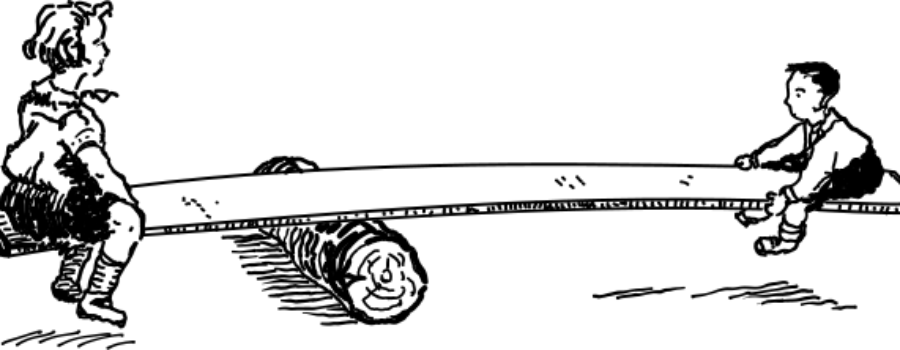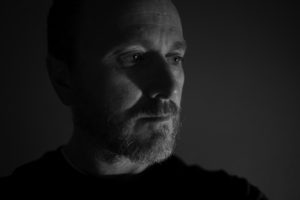Dating is difficult at any age, but the older you get, the more complicated it becomes. As we age we discover what things we need and what balances we need in life. One of the benefits of young people getting married is that if, a BIG if here, they put Christ first, they will grow together. Together they discover themselves and adapt to, and with, each other. This forms the compound that keeps a good marriage together. It takes a lot of work to find balance between the “me” and the “we,” but a marriage at a young age, while the world is still a mystery and self-identities are still forming (research shows this continues into the early 30s), allows for the couple to develop coping skills.
In a recent conversation with someone very dear to me, I came up with the following metaphor. Balance is formed by:
- A fulcrum of hope, joy, caring, love, and peace.
- A beam of common interests, common goals, and mutual respect.
- Two people on the beam with individual interests, goals, and self-esteem.
In all relationships, the beam is established first. Once the two people have measured, hewn, and polished the beam together and decide that yes, this is the beam that will support our relationship, it is set upon the fulcrum – together as a team.
The fulcrum requires constant choice. Both need to choose to have hope for the future. They must choose to believe that joy is possible. They have to choose to love each other every day, even when they would rather love to punch the other in the gizzard. And they have to choose that all things must end with peace. Without these daily – even constant – choices, the fulcrum is unstable and, no matter how beautiful and perfect the beam, there will never be balance.
But then you have the individual. This is where marriages fail or grow, relationships end or deepen, and friendships are time tested. Both people are legitimately and equally expected and need to have individuality. Each person is entitled to free agency and self-awareness. Each person should be an individual and should be allowed to pursue their individuality. Heavenly Father didn’t put us on this planet to be like everyone else, to be dominated or forced into paths we don’t want. He expects us to be individuals, as long as that individual is, or is endeavoring to be, a Disciple of Christ. This is the only requirement He has of us. Everything else is our free agency.
So how do two people wandering on a beam to find their individual balance do so without disturbing the balance of the other? The answer is actually very easy:
They hold hands.
By holding hands, they are satisfying the admonition to be “as one in all things.” “Being one” doesn’t mean a loss of individuality, it means that the unit of two people move together bound by a willingness to adjust their position on the beam so that balance remains. The problem with older people, previously married, and the like, is that we are very comfortable with who we are and what we want. We don’t want to lose ourselves in the effort and desire to be married or loved. Holding hands helps this process as well, because it says to the other “I am my own person, but I choose this ride with you.”
The problem with relationships – marriage or otherwise – is that the world has told us that our needs are important. Well, they are, but not to the exclusion of the other’s needs. That is equivalent of two people, on the beam, moving around for their own comfort with disregard to the other person’s feeling of balance. Two people, moving separately, randomly, leads to a wildly unstable beam. Eventually one gets off. We have all felt that when a “friend” jumps off the teeter-toter and lets us slam to the ground. I think that is a perfect metaphor for what the end of a marriage feels like.
The answer, then, is to hold hands. Each adjusting on the beam together, as a unit, until balance is found. That is the only way to do so. However, I can already hear the objections, but I have proof.
Last year I was floating the Comal River in Central, TX, with a bunch of other singles. I decided I wanted to stand on my tube. I kept trying, losing my balance and falling into the water. Ultimately, I did it, but it didn’t last long. I decided to conduct an experiment and called over a friend of mine. I already saw the opportunity here. She took my hands and we each independently tried to stand while holding hands. Then we tried together and we stood on the third attempt. We also maintained our balance as the tubes moved down the river, showing that two people, working in concert can keep each afloat, even when the individual’s balance shifts.
The same concept (maybe even a better metaphor…) applies here. Life isn’t a static beam, life unbalances us, sometimes things change, sometimes people just grow apart. The greatest argument – that means there is compromise, which means everyone loses equally.
My counter to “compromise means a loss” is that this concept of compromise is wrong. Compromise doesn’t meant I have to give up my needs for the other, compromise is, instead, over time. A bird lands on the other side of the beam it will eventually fly away, so the two move together to adjust until it does. Neither have lost anything, they adjusted temporarily to get through that “hardship.” The other sneezes or gets sick, or gains weight, the couple moves to adjust until they are able to regain balance. The beam is always moving because it is in the same life that we are, and life happens. The only thing compromised is selfishness.
Maintaining balance in a relationship requires constant adjustment, sometimes small, sometimes huge, but balance can be met. If two people are serious about wanting their relationship to work, they can find balance, they can maintain it, but a relationship will never work with two individuals trying to find their own balance on the same beam separately.
I mentioned putting Christ first before even beginning to build the beam. Putting Christ first is the primary step in all things. That is the measurement of the wood. Too short a beam, finding balance is much more difficult and erratic, with little room for adjustment. Putting Christ first gives us the longest possible beam to allow us the greatest flexibility for finding balance. By putting Christ first, we are also inviting someone into our lives that, when the beam feels that it is getting too difficult to adjust, he will intercede and assist. Only, for Christ to intercede, both people, holding hands, must use that position to ask for Him to help.
As you look at a relationship, put Christ first to measure the tree, then form your beam. Choose your fulcrum, join hands and step on the beam to find your balance together. Balance is never perfect and will always require movement, adjustment, and at times, Jesus to step in to right the balance again. We all enjoyed the teeter-totter when it was two people working in concert, there is no reason that finding balance together in a relationship can’t be equally as exhilarating.




